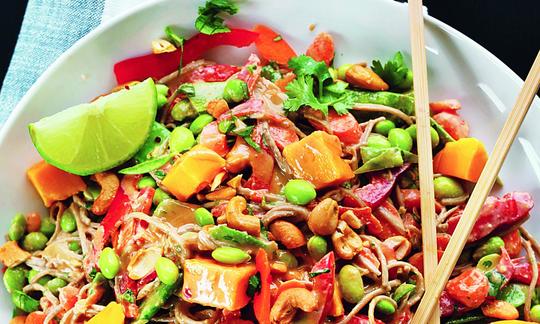Cashew Soba Noodle Salad with Cashew Ginger Dressing
vegan
Ingredients (for servings, )
Equipment
- grater
- whisk
- stove
- citrus juicer (lemon squeezer)
- saucepan
Type of preparation
- cook
- chop or grind
- squeeze
- season to taste
- remove the skin
- grate (shred)
Preparation
For the soba noodle salad
Cook the soba noodles according to package instructions. While the noodles are cooking, prepare the vegetables (next step). When the noodles are ready, drain, rinse with cool water, and set aside.You can replace the soba noodles with gluten-free rice noodles if you’d like.
Wash the vegetables and thinly slice the carrots and bell peppers. Cut the sugar snap peas in half. Peel the mango and cut into bite-size pieces. Coarsely chop the cashews.
To cook the edamame, microwave for 1 minute, covered. Or add to a saucepan over medium-low heat with 1–2 tablespoons (15–30 ml) water, cover, and cook until warmed through, about 2 minutes. Set aside.
If you can’t find fresh edamame, you can use frozen edamame. Defrost before cooking.
For the cashew ginger dressing
Squeeze the lime, peel the garlic, and finely chop the garlic and the chili pepper. Combine all of the ingredients (except the water) and whisk.The original recipe calls for ¾ teaspoon of chili garlic sauce. We have replaced this with ½ chili pepper and one clove of garlic.
We have intentionally halved the amount of agave syrup used in the original recipe.
Instead of the gluten-free Tamari soy sauce in the original recipe, we chose to use genen shoyu, a low-sodium soy sauce. And we have intentionally halved the amount of soy sauce in this recipe.
Add enough hot water to thin into a pourable sauce (~2–3 tablespoons or 30–45 ml, depending on how many servings you’re making). Taste and adjust the dressing as desired.
Serving
Add all of the salad ingredients to a large bowl and toss with soy sauce and toasted sesame oil. Then add the desired amount of dressing. Add a few roasted cashews (options) and thinly sliced lemon for garnish.Serve chilled or at room temperature.
|
Nutritional Information per person
Convert per 100g
|
2000 kcal | |
|---|---|---|
| Energy | 536 kcal | 26.8% |
| Fat/Lipids | 26 g | 36.5% |
| Saturated Fats | 4.8 g | 23.8% |
| Carbohydrates (inc.dietary fiber) | 67 g | 24.7% |
| Sugars | 20 g | 21.9% |
| Fiber | 7.3 g | 29.2% |
| Protein/Albumin | 19 g | 38.7% |
| Cooking Salt (Na:296.8 mg) | 754 mg | 31.4% |
| Essential micronutrients with the highest proportions | per person | 2000 kcal | |
|---|---|---|---|
| Vit | Vitamin C (ascorbic acid) | 111 mg | 138.0% |
| Min | Copper, Cu | 1.3 mg | 129.0% |
| Vit | Vitamin B9, B11 (Folate, as the active form of folic acid) | 242 µg | 121.0% |
| Prot | Tryptophan (Trp, W) | 0.26 g | 103.0% |
| Prot | Threonine (Thr, T, irreversibly transaminated) | 0.70 g | 75.0% |
| Min | Manganese, Mn | 1.4 mg | 71.0% |
| Prot | Valin (Val, V) | 0.98 g | 61.0% |
| Prot | Isoleucine (Ile, I) | 0.74 g | 60.0% |
| Vit | Vitamin K | 43 µg | 58.0% |
| Elem | Phosphorus, P | 399 mg | 57.0% |
Detailed Nutritional Information per Person for this Recipe
The majority of the nutritional information comes from the USDA (US Department of Agriculture). This means that the information for natural products is often incomplete or only given within broader categories, whereas in most cases products made from these have more complete information displayed.
If we take flaxseed, for example, the important essential amino acid ALA (omega-3) is only included in an overarching category whereas for flaxseed oil ALA is listed specifically. In time, we will be able to change this, but it will require a lot of work. An “i” appears behind ingredients that have been adjusted and an explanation appears when you hover over this symbol.
For Erb Muesli, the original calculations resulted in 48 % of the daily requirement of ALA — but with the correction, we see that the muesli actually covers >100 % of the necessary recommendation for the omega-3 fatty acid ALA. Our goal is to eventually be able to compare the nutritional value of our recipes with those that are used in conventional western lifestyles.
| Essential fatty acids | per person | 2000 kcal |
|---|---|---|
| Linoleic acid; LA; 18:2 omega-6 | 5.1 g | 51.0% |
| Alpha-Linolenic acid; ALA; 18:3 omega-3 | 0.27 g | 14.0% |
| Essential amino acids | per person | 2000 kcal |
|---|---|---|
| Tryptophan (Trp, W) | 0.26 g | 103.0% |
| Threonine (Thr, T, irreversibly transaminated) | 0.70 g | 75.0% |
| Valin (Val, V) | 0.98 g | 61.0% |
| Isoleucine (Ile, I) | 0.74 g | 60.0% |
| Leucine (Leu, L) | 1.3 g | 56.0% |
| Lysine (Lys, K, irreversibly transaminated) | 1.0 g | 55.0% |
| Phenylalanine (Phe, F) | 0.85 g | 55.0% |
| Methionine (Met, M) | 0.27 g | 29.0% |
| Vitamins | per person | 2000 kcal |
|---|---|---|
| Vitamin C (ascorbic acid) | 111 mg | 138.0% |
| Vitamin B9, B11 (Folate, as the active form of folic acid) | 242 µg | 121.0% |
| Vitamin K | 43 µg | 58.0% |
| Vitamin A, as RAE | 406 µg | 51.0% |
| Vitamin B1 (Thiamine) | 0.46 mg | 42.0% |
| Vitamin B6 (pyridoxine) | 0.58 mg | 41.0% |
| Vitamin B5 (Pantothenic acid) | 1.7 mg | 28.0% |
| Vitamin B2 (Riboflavin) | 0.35 mg | 25.0% |
| Vitamin B3 (Niacin) | 3.7 mg | 23.0% |
| Vitamin E, as a-TEs | 2.3 mg | 19.0% |
| Vitamin B7 (Biotin, ex vitamin H) | 4.1 µg | 8.0% |
| Essential macroelements (macronutrients) | per person | 2000 kcal |
|---|---|---|
| Phosphorus, P | 399 mg | 57.0% |
| Magnesium, Mg | 191 mg | 51.0% |
| Potassium, K | 932 mg | 47.0% |
| Sodium, Na | 297 mg | 37.0% |
| Calcium, Ca | 98 mg | 12.0% |
| Essential trace elements (micronutrients) | per person | 2000 kcal |
|---|---|---|
| Copper, Cu | 1.3 mg | 129.0% |
| Manganese, Mn | 1.4 mg | 71.0% |
| Zinc, Zn | 3.7 mg | 37.0% |
| Iron, Fe | 5.0 mg | 36.0% |
| Selenium, Se | 5.9 µg | 11.0% |
| Iod, I (Jod, J) | 2.5 µg | 2.0% |
| Fluorine, F | 4.5 µg | < 0.1% |
Narayana Verlag GmbH /Unimedica Verlag , Dana Shultz
Raw recipes 16, Cooked recipes 98 (3)
Additional photos (13)
The recipe book "Vegan. Easy. Delicious. 30 Minutes or 10 Ingredients or 1 Pot" explains simple, everyday yet imaginative vegan recipes.
Since this book is written in German, a description is omitted here. If you are interested, please switch to German in the menu.
This tropical, high-protein cashew soba noodle salad with edamame, mango, cilantro, and cashew ginger dressing is quick and easy to prepare.
Servings: According to the author, the quantities listed are ideal for two main course servings or four side dishes.
Soba noodles: Soba noodles are thin, grayish-brown Japanese noodles made from buckwheat. They are an integral part of Japanese cuisine, and in Japan there are soba restaurants where all of the dishes are made with soba noodles. Soba noodles absorb flavor well and are available in a range of qualities. Cheaper soba noodles may be made with wheat flour and thus contain gluten. The noodles can be eaten warm or cold, and taste delicious in salads.
Sugar snap peas: Sugar snap peas are a pea variety in the legume family. You can eat the entire pod and don’t have to shell them. The flavor is similar to that of peas, but they are slightly sweeter and juicier. In addition to adding sugar snap peas to stir-fries or curries, they can also be eaten raw in salads as they don’t contain any phasin, which causes damage to blood cells and the intestinal wall when consumed in large quantities. Some sugar snap peas have tough “strings” running along the top of the pod from base to tip that have to be removed before cooking or eating raw. Simply snap off the ends of the peas and pull the strings off. Since fresh sugar snap peas don’t keep for that long, they should be eaten within a few days. Alternatively, they can be blanched and frozen.
Edamame: Edamame are protein-rich beans that taste sweet and slightly nutty. In Japanese, edamame literally means “stem beans” and is used to described immature soybeans in the pod. Edamame is a common dish in East Asia; however it is also becoming increasingly popular in Europe and Northern America. It is usually eaten blanched with a little sea salt. Only the beans inside the shell are eaten, not the pods themselves.
Cashew butter: Industrially produced cashew butter is usually made from roasted cashews mixed with oil and flavoring. The result is that it contains high quantities of protein, fat, and calories, which encourages people to eat a lot of it. When buying cashew butter, look out for varieties that do not contain additives, preservatives, or salt. People with a peanut allergy can use cashew butter in place of the peanut butter.
Toasted sesame oil: Toasted sesame oil is made from toasted sesame seeds. It is a great oil for adding flavor to soups, pasta, and vegetable dishes. Its flavor is stronger than regular sesame oil, so be careful when adding it to dishes you are making so that you don’t add too much. Toasted sesame oil should not be used for cooking at very high temperatures, for example, deep-frying.
Storing: Leftovers will keep covered in the refrigerator for 2–3 days, though best when fresh.
Reducing the amount of salt: You can easily reduce the salt content of this dish with some slight modifications (see the section “Alternative preparation”). We recommend the book Salt Sugar Fat by Michael Moss, which provides interesting insights on this topic.
Reducing the amount of salt: You can easily reduce the salt content of this dish with some slight modifications. For example, you can replace the salted cashews in the original recipe with unsalted cashews. You can also use low-sodium soy sauces such as genen shoyu, which contains up to half of the salt content of typical soy sauces.
Replacing cashew butter with almond or peanut butter: If you don’t have any cashew butter, you can replace it with the same quantity of another nut butter. Ideally, use an unsalted nut butter.
Fresh ingredients: We recommend replacing the ready-made chili garlic sauce used in the original recipe with fresh chili and garlic.
Substitute for soba noodles: If you don’t have soba noodles on hand, the author Dana Schultz suggests using gluten-free rice noodles. Rice noodles that you find in the supermarket are made from rice flour; however, tapioca flour or cornstarch are often added to give the noodles their firmness. Rice noodles are among the most widely used ingredients in eastern Asia.




